“Putting the Next Helsinki on Display,” one of the 30 long-listed submissions for the Next Helsinki competition, abandons the proposed location in the South Harbor, and, in fact, the whole premise of a concrete museum building. Instead of envisioning how city developments might change the future of Helsinki, the proposal—submitted under the pseudonym Museum and Migration Group—shifts the focus to the underlying question of how museums play a role in defining national identity. By inviting young Finns of immigrant origin to re-write the cultural narrative on display in the National Museum of Finland, the proposal challenges the prevailing, majority-biased interpretation of what constitutes “Finland,” while also suggesting that success in creating a new museum, or a museum for “the new,” relies not so much on the physical endeavor of construction as on making spaces for new perspectives on the present. “To what extent do new immigrants see themselves on the Museum’s walls or hear themselves in its narrative?” the group asks. “How can the Museum help create a more diverse outside by changing what it does inside?”
The questions brought up by the proposal highlight the fact that a future Helsinki is already in the making, and that this future might have a practical momentum of its own. It also brings into focus the need to re-think sites of representation within the changing landscapes of economics and demography. If museums are considered to be tools or vehicles for nation-making, it should be relevant to ask who its representations are aimed at, who has access to self-representation through its practices, and, most importantly, who is the “we” that is understood to constitute the said nation.
All of these questions are equally relevant to any art institution in any city. The prospects for art have become central to city development worldwide, as art institutions are more and more used as icebreakers for gentrification processes and as magnets for international tourism. Art is seen as a way to bring capital, attention, and global perspectives to otherwise remote corners of the world, and as having the capacity to mobilize populations and re-vitalize neighborhoods. But in most cases of urban-planning discussions that revolve around art museums, a lot is said about the function of art institutions in society, and about the function and benefits of investment in these institutions, and very little about the function and role of art itself. As a result, public discourse seems to be doomed to loop around public spending and private interests, never touching on the weightier topic of art’s relation to social value systems at large.
Instead of deriving the function of art institutions from the economic matrix in which they are built, I propose to start by asking, What is the function of art in today’s society? And in this society in particular, how do we want to see art do its work in the future? And how shall we derive the functions and structures of the institutions from the outcomes?
Art and Civic Society
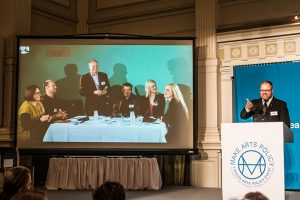
Make Arts Policy. The event by Checkpoint Helsinki, Baltic Circle festival and Public Movement invited all Finnish political parties and the local art scene to discuss arts policies. Helsinki, 2014. Photo Noora Geagea
In 2014, the Arts Council of Finland gave out 32 million euros in grants to arts and culture. Even if this sum represents just a fraction of the entire culture budget of 450 million—which is just 3.3% of the country’s GDP1—state-run grant programs, prizes, and artist pensions are among the main sources of funding for Finnish artists as well as for small art organizations and independent groups. Because there are no native billionaires nor an internal art market, most art institutions throughout the country get their main funding either from the state or the city. This goes for the gallery scene, too: the most common way of running a gallery is through an association (that also receives its main funding from the public sector) established either by artists or artists’ unions. Besides the funding from the public sector, the art scene relies on four or five major grant foundations, such as Scandinavia’s biggest private art foundation, the Finnish Cultural Foundation, that—unlike typical U.S. philanthropy funds—was originally established by public fund-raising.
Even if public funding for the arts seems generous, only a very small percentage of professionals can make a living purely out of their art practices. The actual foundation of arts funding is the welfare state, with its free education and free health-care system, along with a network of social-security services such as unemployment benefits and paid, nine-month parental leave that enable people to survive and stay functional even when unemployed or in low-wage jobs. Most artists rely on unemployment benefits to continue developing their practice in the often long periods they spend without direct funding.
The Finnish Arts Council was originally modeled on the Arts Council of Great Britain, whose architect was the economist John Maynard Keynes. So were the National Endowment for the Arts in the U.S. and the Canada Council for the Arts. According to Keynes, the market economy was an instrument for the good life, not a goal unto itself, and if a society thought art was important, it needed to channel resources for sustaining that sector, similarly to other “un-productive” fields of social life that people decided were valuable, such as social security or health-care systems for people who were not capable of lifelong productive work.2 The influence of Keynesian economics was widespread during the 50’s and 60’s, when the Nordic welfare state was created, and its principles still inform the basic architecture of Finnish society. In this context, and ideally, art has been understood as a core part of a functioning society. Art, together with access to education and a state-supported opposition, all aim at enabling dialogue and providing people with tools for understanding and participating in society. Thus Finns are famous for being literate—this is not only because of the education system, but also because of an extensive network of library services that have been provided by library buses to places that were too remote for permanent cultural infrastructure. Almost every city or larger town has a theatre building, and statistically every one of the five million Finns go to the theatre once a year. The visual arts have not achieved such a central role in the culture, but nonetheless there is an art museum in almost every city. The underlying idea is that art should be accessible to everybody—and thus become one of the pillars of civic society. This strategy reflects the core value of equality that has been central to the Nordic social democracies. Freedom of artistic expression is explicitly safeguarded in the Constitution, according to which the state should provide infrastructure and funding for the arts, and leave content management to the peer-review structures of the funding bodies.3 In the rare cases when the authorities or museums do interfere, it is usually only after the display of controversial content, not before. This allows for people to participate in the process of debating the limits of free speech and public discourse.
There are of course many challenges that arise from the top-down structures of a strong state, as well as from the history of a nation that has been demographically homogenous and geo-culturally isolated. In a society that is as closed to the outside world as Finland has been, and that provides material security for all, the arts have been able to immerse themselves in formal rather than political exploration. Finnish contemporary art is exceptionally high in technical quality, rich in experimentation, and wonderfully diverse in terms of content and approach. Social art practices and explorations using new media or performance are almost as equally well supported as the more traditional mediums of sculpture and painting. But because of the top-down funding there is little collaboration and even less constructive competition, which can lead to art practitioners becoming indifferent to their audiences as well as to the societal aspects of art-making. Debates are small-scale, and if they do not adopt the language of English they never find their way into the currents of international discussion. More and more local artists work in international contexts, but for a foreigner it is still difficult to gain a footing in the local scene. In many ways Finland is still a society that is difficult for outsiders to enter. Under these circumstances, forming an identity in the international context is an ongoing challenge for the nation.

Mammalian Diving Reflex:These Are The People in Your Neigbourghood. The project hosted a workshop and a guided tour, run by local children, in the culturally diverse neighbourhood of Vuosaari, Helsinki. Curated by Eva Neklyaeva for Checkpoint Helsinki. Photo: Noora Geagea
Today, these historically secure living and working conditions are changing rapidly, and as a result the art scene is seeking new directions. The strong state model of egalitarian social democracy that for decades was considered to be the cornerstone of the nation is increasingly and frequently referred to by the current right-wing government as an “obstacle” in the way of modernization. The structures that were once devised to address and correct economic inequality are being targeted as vehicles of irresponsible spending, while the wealthiest citizens and companies benefit from taxation policies that are more and more regressive. More and more, the arts and academia have to justify their very existence, and are forced to adopt evaluation models that come from the corporate world, where fiscal efficiency is the only recognized value. Consequently, the inequality gap is widening on all fronts of society.
Simultaneously, Finnish society is becoming more and more diverse. Every country has an origin story that reflects the core values with which the nation identifies. In remote, homogenous, and historically colonized Finland, this story has concentrated on “sameness against the outside world.” Thus, the social-democratic dream of economic equality has fit this national mind-set like a glove. But, whereas in 1990 foreigners made up only an amazingly small 0.5% of the population, today the figure is 3.8% and growing rapidly.4 It might be difficult for an outsider to understand that a modern Western country can arrive at ethnic and cultural diversity as late as the 2000’s.
Origin stories, of course, are also fantasies that reflect the interests and perspectives of those at the top. In Finland, this myth of sameness required the routine suppression of diversity inside the country (discrimination against the minority Roma and Sámi), as well as a denial of the country’s ties to European colonial history. With the new generations of non-Caucasian, non-Christian Finns who rightfully claim the country as their own, the myth itself is threatened—along with the justification for the privilege that comes with it. Boosted by the refugee crises and silently approved by the populist right wing in power (the leading politicians form a uniform image of the myth in their all-white, male, middle-class presence), hate speech against minorities and racist violence has burst into flame.
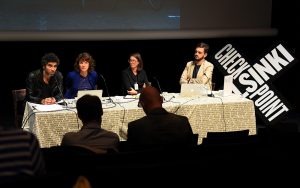
Symposium “We are open” in the first year of Checkpoint Helsinki 2013. From left to right: Can Gülcü, Katharina Morawek, Nora Sternfeld, Matteo Luchetti. PhotoTitus Verhe.
Under these circumstances, the pressures on the local art world are twofold.
On the one hand, the top-down funding model has made the institutions vulnerable to radical political change, as has been seen all over Europe when right-wing governments have started applying austerity policies. Institutions are struggling to secure basic funding as the public sector diminishes year by year. In many cases, the cuts leave institutions functional in terms of permanent staff and venues, but with little or no money for ambitious programming or art collecting. Third-party funding is a requirement for receiving public funds, but since there are very few private investors, the institutions are between a rock and a hard place. As instrumentalizing business language penetrates the culture sector—where success in international competition is key—cultural policy-makers channel funds into various kinds of branding or internationalization programs. In order to maintain their basic functions, institutions put enormous effort into maintaining a presence at art fairs and pop-ups abroad that look good on paper but which often have few or no long-term consequences for either art or the artists involved. And as international success has become the measure of accomplishment for both artists and organizations’ programming, the local grassroots scene struggles even more.
On the other hand, it has become more and more unclear who the art institutions are there for. Cultural discourse is dominated by leftist, liberal views, but institutional practices increasingly reflect the values of the conservative right. Art audiences cannot be defined by the monoculture Finland of the past; the country is increasingly divided, economic inequality is widening rapidly, and the educational ideal of “art for all” is being challenged by the necessity to serve the few at the top.
The prospects for international success
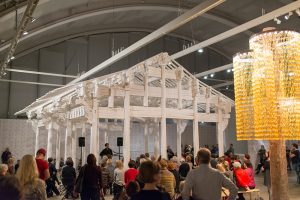
Museum club, a continuous collaboration between Checkpoint Helsinki and Museokortti, at Helsinki Art Museum Ai Wei Wei exhibition, 2015. Photo Noora Geagea.
For someone familiar with the art world mainly through the mass media, it might seem that the arts have never flourished as they are today. Auction houses release news of sales records that seem to climb ever higher, with no end in sight: €50 million for a Hirst, $46.5 million for a Richter, $170 million for a Modigliani, $179 million for a Picasso. The yachts parked off the Giardini Biennale park in Venice seem to double in size every year, and more and more celebrities (Beyoncé! Pitt! DiCaprio!) are seen harvesting the art at auctions and galleries. There is money: the art market amounted to $50 billion in 2015—close to the sum that circulates in the global arms trade.5 Fairs get bigger and fancier and their VIP lounges more flashy: 100,000 visitors to ArcoMadrid, 72,000 to Art Basel Miami Beach, 98,000 to Art Basel.6 Art collecting has become a booming field of investment that spins so fast there is hardly time to ship the work from seller to buyer; thus the need for museum-sized private storage for first-class art, such as Uovo’s $70 million art-storage building in New York, where the perfect conditions make it unnecessary to take the work out of the building, even at the time of the sale.7
With the pressure to finance art-making and the basic functions of public art institutions, access to the circulation of capital in the art market seems tempting to museums, nonprofits, and independent artists. What we see is that the great names that fill the major museums of the world are also the ones making major sales, and thus it is easy to think that the big numbers are generated by the cultural value of the work. So little is said about the formation of value in the art world that successful art has become a synonym for success in the marketplace.
In this brutal market-driven reality, the art boom merely reflects the priorities of end-of-times capitalism, where a diminishing minority mines profit on the backs of the majority. Traditional collectors are replaced by speculative financial collectors, who see art merely as an investment. “It’s been a very, very thin market,” said top art dealer David Nahmad as early as 2009, “with just two or three dealers pushing up prices by bidding against each other.”8 Art has become an unregulated field of investment that grows so fast even the dealers and high-selling artists are starting to sound the alarm; just recently, Gerhard Richter, one of the highest-selling living artists, spoke out about prices (including those of his own paintings) “having nothing to do with the work.”9 According to the artnet news report, “The market that Art Basel Miami sits atop is not part of the overall economy; instead it’s part of the economy of a small subset of Global Ultra High Net Worth Individuals.”10 As a growing field of speculative investment and money laundering, the art market not only reflects the economic inequality of the world, it has become part of the problem.
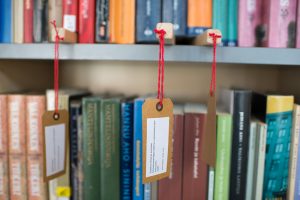
South African collective Chimurenga & Pan African Space Station at Kallio library, 2016. Part of a 3-part program Memories of Silence, curated by Ahmed Al-Nawas for Checkpoint Helsinki, 2015-2016. Photo Noora Geagea.
While the prices of contemporary art are skyrocketing and public funds are diminishing, nonprofits, galleries, and even major museums and biennales have become dependent on collectors. The prices are so high that even major international art museums cannot purchase art works from key artists. As a result, museums are dependent on loans and gifts from collectors, for whom museum exhibitions provide much-needed exposure, and a way to pump up the value of the investment. When the work’s monetary value on the market is overshadowing other types of value systems, programming tends to lean toward the conservative tastes of the market.11 (Not long ago, I was supposed to participate in a group exhibition at a U.S. museum that eventually canceled the whole show after a poll by an audience consisting of wealthy benefactors in the area nixed the plan.) The idea that museums serve people by exposing them to challenging content and enabling them to discuss and engage in the issues of the art world is being supplanted by the model of serving up to (paying) audiences what they already know (a parallel development to that of the university world, where teaching staff are cornered by paying student-customers who demand content that fits their personal career goals). Censorship is not imposed top down by the state, but instead as more subtle interference by private interests that filter out inconvenient content even before it is visible to the public. Not surprisingly, for example, the problematic aspects of economic inequality that are intertwined with those of race or environment remain almost completely absent from the exhibition programming of major U.S. art museums.
Just as in the corporate global economy, wealth based on art assets is flying upward, not trickling down. Moreover, the institutional art world relies heavily on the free labor of artists and other cultural practitioners, as well as on the low-wage input of construction and maintenance workers. Working for free in the culture sector, on the other hand, is a possibility only for those who have independent means, so access to family wealth is often a requirement for entering the field in the first place. In The Guardian’s report on a U.K. study on work in the culture sector,12 90% of respondents were required to work for free at some point in their careers—a choice available only to those who can afford it.13 A study by NPR found that the difference in income between parents and children in the U.S. is biggest in the arts: in other words, people whose parents have wealth are more likely to take the risk of getting into the low-paying business of art-making.14 Hadrian Garrard, the director of the U.K. art organization Create, warns that the U.K. is in danger of “returning to the pre-50’s era when arts was considered to be largely the preserve of the rich.”15 As Ben Davis writes in his brief report on the backgrounds of best-selling artists, “Beneath the surface of [a] wildly pluralistic art world, family wealth is a connecting thread.” According to Davis, the creative sector is becoming “a closed shop, particularly to those from black, Asian and ethnic minorities and less affluent backgrounds.”16

Ahmed Ögüt: Fahrenheit451. Three fire trucks around the city printed out copies of previously censored books. Commissioned by Checkpoint Helsinki 2013. Photo Oliver Kochta-Kalleinen.
While the art world defines itself as international, it is worth remembering that internationality is no guarantee of diversity. The discriminatory race and gender divides that define the global economy are not only reflected by, but are also amplified in, the art world A recent study found that the New York City art scene is 200% more white than the city’s population.17 People of color appear largely as representatives of a minority rather than as equal participants in the discourse. Gender is another issue: despite feminist art and the gender-conscious institutional critique currently being applied in art history and theory, male dominance is still manifest in practice. The closer to the top, the less diversity; Google any list of the top 10 or top 50 most expensive artists and you find that nearly 95% of them are male. Thirty years after the Guerrilla Girls, women still make up only roughly 30% of artists in major biennales and museum shows—and that’s in the best-case scenarios. In the worst-case scenarios, the numbers are far lower, as with solo shows at Guggenheim NY (14% women in 2014), Centre Pompidou (16% women in 2015), or group shows at the Metropolitan Museum of Art (4% women in 2012) or MoMA (7% women in 2015).18
As a result of the numerous thresholds that keep diversity of perspective out of the discourse, homogenization of content is increasing. Research by the Art Newspaper discovered that almost one-third of the artists who had solo shows in U.S. museums from 2007 to 2013 came from only five galleries.19 The same internationally renowned works tour from biennale to triennale to art fair, having less and less connection to local processes while accruing value in the speculative space of the market. Just as in the music business (or real life), the middle class (mid-priced artists, mid-income households) are getting poorer, while the few who succeed are making it big-time. This unrealistic notion of success is saturating the media space and holding up the false illusion that anyone can succeed, when in fact almost no one can.
What is evident, then, is that a large part of the international art world is developing into a set of tailored investment services for the privileged, protecting the interests and views of those already at the top. The lower parts of the pyramid—publicly funded museums and other institutions, non-profits, and artists—are increasingly working in the shadow of this process, while having to adapt to its values and mechanisms.
Re-creating society
In his “Relational Aesthetics,” Nicolas Bourriaud famously stated that art has always been relational: in prehistoric times it was a way of relating to the forces of nature, in historical times to God, and in the modern era to the sphere of the social.20 Thus the function of art has also been bound to the prevailing condition of modern life, and dominated by the rise of the capitalist economy. Much of the debate that we are having today about the role of art under commercial pressures or the loss of art’s meaning for bourgeois society is identical, practically word-for-word, to that of the early avant-garde in the late 19th century. Since that moment, the history of modern art can be seen as a continual series of escape strategies, where every new art form or movement has been hailed by its contemporaries as the one that finally cannot be commercialized—until, of course, it is. The social practices and political art we are seeing today are just the latest round in a century-long wrestling match that will perhaps only be resolved at the twilight of the capitalist era.
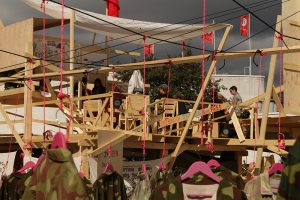
To The Square 2. The outside exhibition, curated by Marita Muukkonen and Ivor Stodosky for Checkpoint Helsinki 2014, features works by international artists involved in forms of resistance. Photo Jani Ahlstedt
While more and more fields of human endeavor are being instrumentalized, and the space for critical thinking and exploration of meaning within the framework of art institutions is diminishing, many renowned and emerging artists are fleeing the art scene altogether. Many of the art forms that are emerging today are coalescing into societal practices, and, instead of creating clearly distinguished forms of art or even critiquing existing institutions, they are appropriating social forms for re-creating society. Artists run conferences, form political parties, establish alternative political structures and academies, rewrite laws, grow community gardens, run laundromats, host residencies, or buy apartment blocks that transform the community on a permanent basis. The range and style of these projects varies so much that it is hard to find a common thread among them—besides the fact that all of them try, in one way or another, to open up spaces where alternative societal futures can be tested. Despite their myriad forms, they stand united in their resistance to what Mark Fisher called “capitalist realism”21 and the idea that now seems to penetrate all forms of thinking: that life beyond predator-capitalism is unimaginable.
It is no surprise, then, that one of the societal institutions that has been tested throughout the history of contemporary art is the institution of the museum. Museums are central to the modern, and they have served from the beginning as sites for the display of power, the distribution and validation of (selected) knowledge, and as treasuries of wealth. What is shown inside the museum, who has access to it, and whose representations are exhibited has an enormous political impact on the world around it. Today, the politicization of economics has shifted the focus of institutional critique from identity politics to the structures of class and power. Today’s art and activist projects often focus on the underlying conditions that enable institutions to exhibit distorted narratives of the shared reality in order to secure the power of the privileged. Campaigns by Liberate Tate and the Natural History Museum, and ongoing projects by the artist-activist collective Not an Alternative, have successfully pressured museums to cut ties with the fossil-fuel industry.22 The Gulf Labor Coalition has focused on worker’s rights and the exploitation of labor in the international museum industry. The Center for PostNatural History, a permanent institution working on the boundaries of art and science, challenges the narrative of “the natural” in the natural history and science traditions.23 My own collaborative project, The History of Others, aims to challenge the human-centered history writing that makes it possible for us to view other beings as mere resources.24
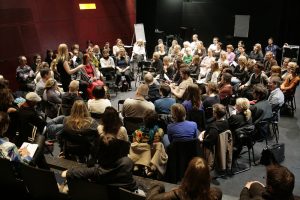
Symposium “We are open” in the first year of Checkpoint Helsinki 2013. From left to right: Can Gülcü, Katharina Morawek, Nora Sternfeld, Matteo Luchetti. PhotoTitus Verhe.
Following in their wake, arts platforms for making and experiencing art are also being explored by artists and other practitioners. Checkpoint Helsinki, one of the organizers of the Next Helsinki competition, came about as a collective response by the local art scene to the question of what a future museum for contemporary art should look like. It did not start out as an art project and was never meant to be one; it is a professional art organization run by a professional staff.25 Still, it is no coincidence that many of its founding and board members have been artists. Artists’ input into the creation of Checkpoint Helsinki has been its abiding strength: creative imagination is one of the major forces in the world that are keeping alternative futures open for debate.
While acknowledging the issues that traditional museums struggle with, Checkpoint Helsinki is using the notion of “a museum” as a starting point for developing platforms that augment the practices of existing institutions. It works by commissioning new work from emerging international artists, facilitating collaboration between local and international communities, and has the goal of bypassing the corrupted art market by making it possible for the city to collect art works directly through its own commissions. It is not a physical museum, but, rather, a tool for probing the future and harvesting what might become an important archive of today, and thus participating in the making of future art canons. By inviting curators and other practitioners to answer the question “What is the future of contemporary art?” by producing new art works, Checkpoint Helsinki inspires participants to reflect on and discuss current values. By organizing its structure around a question rather than on a goal, it aims to avoid institutionalization and to keep the focus on meanings rather than on production for production’s sake. Instead of starting by building walls and infrastructure, it starts by creating content—art and discourses—around which walls can one day grow, if needed. In this way, it helps to develop the local and international art scene in a manner that is rooted in the values of sustainable growth and diversity of perspective.
Resisting the erosion of meanings
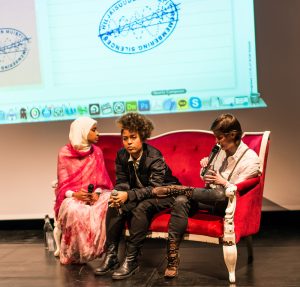
Outlines. Feminist film festival by Maryan Abdulkarim and Pauliina Feodoroff. The event was part of Remembering Silences program, curated by Ahmed Al-Nawas for Checkpoint Helsinki 2015-2016. photo Noora Geagea
Today, Finland is at a crossroads where alternative futures are vying with each other. We are exiting the era of monocultures and the myth of sameness, and entering a world that is overwhelmingly complex and diverse. No one knows for sure which future will become reality. What we do know is that the dominant narrative of neoliberal economics is capturing more and more of our public imagination and making us believe that there are no alternatives. There is a danger of slipping from one (historic) monoculture into another one—of polarized classes whose realities are so at variance that they become unrecognizable to each other. Yet, in contrast to many other Western countries, Finland is at a point where multiple different futures are still possible and the social welfare project has not been fully extinguished. It is still possible for the country to choose a path that is sustainable and that adapts its core values of equality and the common good to the new global situation, instead of adopting the values of predator capitalism, i.e., those of exclusion and inequality.
The art historian Laura Kokkonen writes about the condition of “erosion of meaning” that is symptomatic of contemporary societal landscapes.26 As the focus of human activity shifts from pursuing the common good or other largely unmeasurable values to pursuing strictly measurable or monetary ones, the question of the good life starts to disappear from sight. Information fills the media space, but when there is little or no time to internalize everything coming at us, it becomes more and more difficult to extract meaning from the noise. Because Kokkonen sees art as an important forum for the basic study of meanings, we are losing the tools to make sense of it all. “The opposite of the erosion of meanings is not a society that has a common goal, but a society where new meanings are actively discussed, where silenced meanings are given a voice, and where conflicting meanings have room to co-exist.” Besides the base level of meanings there also needs to be a common goal meaning, for which Kokkonen proposes the meaning of peace. But “the function of art is to be a site where this supposedly shared goal of meanings can be challenged and debated, and this is what makes all art political.”
In a time of eroded meanings, it is possible to engage in discussions about internationality or success without stopping to ask what they actually mean, and what kinds of values are pursued through these ambivalent concepts. What we have seen is that the international art world does not necessarily engender greater inclusion, diversity, or expansion of dialogue—and in many cases it can entail the exact opposite. It is necessary to consciously focus on what kind of international exchange we wish to reinforce, and how best to facilitate that process.
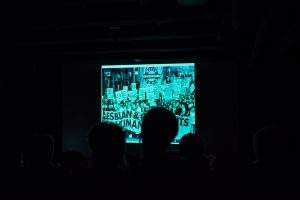
Outlines. Feminist film festival by Maryan Abdulkarim and Pauliina Feodoroff. The event was part of Remembering Silences program, curated by Ahmed Al-Nawas for Checkpoint Helsinki 2015-2016. photo Noora Geagea.
Equality has been one of the central values of Nordic social democracy. If we still see it as a value that we want to hold on to, then the art world should consciously resist practices that weaken equality by celebrating values other than those dictated by the market apparatus. In their quest for diversity, the institutional structures of the arts should be aware of the dark side of the art world—that of the cultural heritage of our shared colonial past: white privilege and the use of art as an instrument of power—while appreciating advancements in the diversity of voices and perspectives, the self-representation of minorities, content-driven global networks, and overall accessibility.
The re-evaluation of the notion of internationality is closely linked to the need to re-evaluate the rhetoric of success that saturates our media space and effectively presents artists as models for international success stories. The Finnish curator Jussi Koitela notes that the identity politics that have helped the liberation of marginal identities can also serve to bolster the neo-liberal agenda and nationalist currents.27 The state, he says, has the power to “[appropriate] the ‘successes’ of anyone carrying its passport into the capitalist-nationalist narrative and harness it to drive up competitiveness.” Artists and cultural practitioners who remain dependent on state funding are effectively used for these goals. This is also visible in the way that the Finnish cultural scene is united in its protests against cuts in public funding, while at the same time using the existing funds to compete on the international art market that services the very ideology behind the cuts. Koitela writes: “Rather than continuing to perpetuate the nationalist and neo-liberal narratives, arts institutions based in Finland and in receipt of Finnish funding could perhaps commit to long-term collaborative relationships with other arts sector professionals and organizations engaged in generating critical supranational narratives in a world that finds itself in the grip of an economic, social and ecological crisis.”
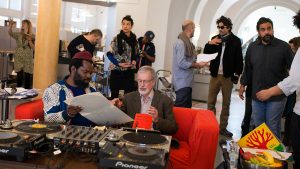
South African collective Chimurenga & Pan African Space Station at Kallio library, 2016. Part of a 3-part program Memories of Silence, curated by Ahmed Al-Nawas for Checkpoint Helsinki, 2015-2016. Photo Noora Geagea.
Art and culture define one of the fields where alternatives to mainstream economics that are marginalized in the curricula of universities and in public debate have been brought into the discussion. In post-Keynesian economics—which has drawn increasing attention—the market is not a natural force that guides the world according to its laws. Its advocates reject the idea that individual self-interest always leads to public good. Instead, the goal, functions, and mechanisms of the economy are defined in the sphere of the political: it is up to society as a whole to decide how to regulate, guide, and use the markets. What is needed, then, is a discussion of the values and long-term societal ideals that precede the use of market forces to realize them. If there is the political will, the means will be there. And in order to find a political solution we will need platforms that allow us to discuss our values and the challenges for the future.
The writer and economic-cultural theorist Paavo Järvensivu works alongside artists in the BIOS independent research group for cross-disciplinary study on the societal challenges of environmental crises.28 Järvensivu, who is a post-Keynesian, argues that if we look at the contemporary reality from the perspectives of climate change and energy availability it becomes evident that we have no other choice than to abandon our carbon-intensive infrastructure and build a post-fossil alternative.29 The discourse that takes as its goal increasing all kinds of production to produce a monetary surplus is not helping us in this transformation. Järvensivu takes issue with Finland’s Minister of Economic Affairs Olli Rehn, who has defined the function of universities as facilitators and innovators of new products and services.30 In Järvensivu’s view, universities should, instead, be dedicated places for studying how people could live a good life with less dependence on increasing production and consumption. Thus, old-school institutional criticism is not enough—we need to start researching new infrastructures and, if needed, to start re-creating society.

Mammalian Diving Reflex:These Are The People in Your Neigbourghood. The project hosted a workshop and a guided tour, run by local children, in the culturally diverse neighbourhood of Vuosaari, Helsinki. Curated by Eva Neklyaeva for Checkpoint Helsinki. Photo: Noora Geagea
There are numerous studies that conclude that investment in the arts is a profitable one for the community. The questions become, What kind of values do we wish to reinforce, and what kind of an investment benefits the whole community in a sustainable way? If we—as a city, as people, as art and culture practitioners, activists, and institutions—see inclusion, diversity, and sustainability as central values, we should seek out structures that enable these values to manifest themselves, including in and through the arts. But we should also be cautious about any attempt to restrict art to fulfilling a predefined function. When Laura Kokkonen describes art as a site for challenging the goals of the society, she is not trying to define art in terms of its instrumental value. Art is a site, not an instrument; it is a site without which we cannot see the values and goals of society, or what kinds of instruments we should be constructing. Thus, securing the existence of this site is not just about securing this or that amount of tax money for the practices of art-making, but about guaranteeing physical and mental spaces where free thinking is possible. Art that is exhibited, circulated, and evaluated purely for its capacity to generate monetary value cannot ever fulfill this crucial function.
The proposal by the Museum and Migration Group for re-curating the exhibit at the National History Museum of Finland is an example of many emerging practices within and around the arts: deconstructing national narratives; focusing on immaterial rather than material production; promoting dialogue and diversity; and exploring the way that art can be a platform for creative thinking for academics, activists, museum staff, international networks, and local communities—not just for artists. The proposal is just one of the more than 200 submitted to the Next Helsinki competition. Many of them are utopian, many practical, many optimistic, some skeptical. But the common thread is that they demonstrate that all kinds of futures can be imagined.
Just as the destiny of the planet cannot be left in the hands of the hyper-rich 0.01%, the future of art cannot lie in the overheated art market. It is elsewhere—in the multiple centers around the world that are local and specific, yet globally interconnected. And it is not through the universal law of profit mining, but through networks of interests, identities, cultures, and languages. If a city wants to invest in the future, this is where the real stakes are: in building an environment where systems of representation are not dominated by one group only; where success is defined by the values of the good life, critical thinking, surprise, and awe; and where internationality originates in exchanges among of the many cultures that already co-exist as neighbors.
Terike Haapoja is a visual artist and the Chairman of the Board of Checkpoint Helsinki.
This text will be published in: The Helsinki Effect – Public Alternatives for Guggenheim Model of Cultural Development. Ed. Terike Haapoja, Andrew Ross. Michael Sorkin. Terreform RU, 2016
References
Alden, William: Art for Money’s Sake nytimes.com 03/15/15
http://www.nytimes.com/2015/02/08/magazine/art-for-moneys-sake.html
Arts Promotion Centre of Finland taike.fi
Bourriaud, Nicolas: Relaltional Aesthetics. Les Presse Du Reel,Franc; Les Presses Du Reel edition (1998)
Davis, Ben: Do You Have To Be Rich to Make It as an Artist? news.artnet.com 01/14/16
https://news.artnet.com/art-world/do-you-have-to-be-rich-to-succeed-as-an-artist-403166?utm_content=buffera8c76&utm_medium=social&utm_source=facebook.com&utm_campaign=socialmedia
Ellis-Petersen, Hannah: Middle class people dominate arts, survey finds. theguardian.com 11/23/15
http://www.theguardian.com/artanddesign/2015/nov/23/middle-class-people-dominate-arts-survey-finds?CMP=share_btn_fb
Fischer, Noah: Agency in a Zoo: The Occupy Movement’s Strategic Expansion to Art Institutions. field-journal.com issue 2/2015
http://field-journal.com/issue-2/fischer
Fisher, Mark: Capitalist Realism. Zero Books 2009.
Goldenberg, Suzanne: US museums asked to sever ties with fossil fuel industry. theguardian.org 03/24/15
http://www.theguardian.com/environment/2015/mar/24/us-museums-asked-to-sever-ties-with-fossil-fuel-industry
Halperin, Julian: Almost one third of solo shows in US museums go to artists represented by just five galleries 04/02/15
http://old.theartnewspaper.com/articles/Almost-one-third-of-solo-shows-in-US-museums-go-to-artists-represented-by-just-five-galleries/37402
Johnson, Andrew: Contemporary art is a fraud, says top dealer. 02/11/09
http://www.independent.co.uk/arts-entertainment/art/news/contemporary-art-is-a-fraud-says-top-dealer-1628929.html
Järvensivu, Paavo: Hyvän elämän politiikka niukkojen resurssien maailmassa. Mustarinda journal 2013 KEYNES
http://www.mustarinda.fi/en/publication
Kinsella, Eileen: World Art Market passes $51 billion Says 2015 TEFAF Art Market Report news.artnet.com 03/11/15
https://news.artnet.com/art-world/2015-tefaf-art-market-report-key-findings-275328
Koitela, Jussi: Arts institutions must offer alternatives to nationalism. finncult.be 01/20/16
http://www.finncult.be/jussi-koitela-laat-kunstinstellingen-alternatieven-bieden-voor-nationalisme/?lang=en
Kokkonen, Laura: Taide ja merkityskato. mustekala.info 11/17/15
http://www.mustekala.info/node/37585
Levitin, Michael: The Triumph of Occupy Wall Street. theatlantic.com 06/10/15
http://www.theatlantic.com/politics/archive/2015/06/the-triumph-of-occupy-wall-street/395408/
Neuendorf, Henri: Gerhard Richter Says He’s Shocked by the Atate of the Art Market. news.artnet.com 12/23/15
https://news.artnet.com/people/gerhard-richter-criticizes-art-market-398694
Reilly, Maura: Taking the measure of sexism: facts, figures, and fixes. art news.com 05/26/15
http://www.artnews.com/2015/05/26/taking-the-measure-of-sexism-facts-figures-and-fixes/
Salusjärvi, Aleksis: Miten käy kulttuurin SIpilän hallituksen vallan alla. yle.fi 05/08/15
http://yle.fi/aihe/artikkeli/2015/05/08/miten-kay-kulttuurin-sipilan-hallituksen-vallan-alla
Saltz, Jerry: Zombies on the Walls: Why Does So Much New Abstraction Look the Same? vulture.com 07/17/14
http://www.vulture.com/2014/06/why-new-abstract-paintings-look-the-same.html
Steinhauer, Jillian Report Finds NYC’s Art World 200% Whiter Than its Population. hyperallergic.com 06/30/14
http://hyperallergic.com/135474/report-finds-nycs-art-world-200-whiter-than-its-population/
Talouselämä
http://www.talouselama.fi/uutiset/suomessa-asuvien-ulkomaalaisten-osuus-eu-maiden-pienimpia-6240685
Viveros-Fauné, Christian: Christian Viveros-Faune on Why Art Basel in Miami Beach is Degrading for Art and Artists. news.artnet.com 12/04/15
https://news.artnet.com/market/art-basel-miami-beach-degrades-artists-385643?utm_content=bufferbce2c&utm_medium=social&utm_source=facebook.com&utm_campaign=socialmedia
Quoctrung Bui: Who Had Richer Parents, Doctors or Artists? npr.org 03/19/15
http://www.npr.org/sections/money/2014/03/18/289013884/who-had-richer-parents-doctors-or-arists
Other references
artbasel.com
http://www.ifema.es/arcomadrid_06/Prensa/NotasdePrensa/INS_051215
The Constitution of Finland
https://www.finlex.fi/fi/laki/ajantasa/1999/19990731
Panic! survey by Create, Goldsmiths University, University and Sheffield and LSE
http://createlondon.org/create-announces-the-findings-of-the-panic-survey/
1Arts Promotion Centre of Finland taike.fi and Salusjärvi, Aleksis: Miten käy kulttuurin Sipilän hallituksen vallan alla. yle.fi
2Järvensivu, Paavo: Hyvän elämän politiikka niukkojen resurssien maailmassa. Mustarinda journal 2013 and Holappa, Lauri: Vaihtokaupasta rahatalouteen. Mustarinda journal 2013
3Finnish Constitution 16.3§. see finlex.fi
4See vaestoliitto.fi and talouselama.fi 18/12/15 Suomessa asuvien ulkomaalaisten osuus Euroopan pienimpiä
5Kinsella, Eilen: World Art Market passes $51 billion Says 2015 TEFAF Art Market Report news.artnet.com 03/11/15
6artbasel.com, http://www.ifema.es/arcomadrid_06/Prensa/NotasdePrensa/INS_051215
7Alden, William: Art for Money’s Sake nytimes.com 03/15/15
8Johnson, Andrew: Contemporary art is a fraud, says top dealer. 02/11/09
9Neuendorf, Henri: Gerhard Richter Says He’s Shocked by the State of the Art Market. news.artnet.com 12/23/15
10Viveros-Fauné, Christian: Christian Viveros-Faune on Why Art Basel in Miami Beach is Degrading for Art and Artists. news.artnet.com 12/04/15
11A good example is what critic Jerry Saltz mocked as “zombie formalism”: high-priced contemporary art that is collector-friendly in its resemblance to modernist works but offers no new insight into either art or the world. See Saltz, Jerry: Zombies on the Walls: Why Does So Much New Abstraction Look the Same? vulture.com 07/17/14
12 Panic! survey by Create, Goldsmiths University, University and Sheffield and LSE
http://createlondon.org/create-announces-the-findings-of-the-panic-survey/
13Ellis-Petersen, Hannah: Middle class people dominate arts, survey finds. theguardian.com 11/23/15
14 Quoctrung Bui: Who Had Richer Parents, Doctors or Artists? npr.org 03/19/15
I myself am a good example of this: my grandparents made it as architects, while their children and grandchildren are almost all occupied in the arts or the culture sector, mentally and financially secured by their background of relative family wealth.
15Ellis-Petersen, Hannah: Middle class people dominate arts, survey finds. theguardian.com 11/23/15
16Davis, Ben: Do You Have To Be Rich to Make It as an Artist? news.artnet.com 01/14/16
17 Steinhauer, Jillian: Report Finds NYC’s Art World 200% Whiter Than its Population. hyperallergic.com 06/30/14
http://hyperallergic.com/135474/report-finds-nycs-art-world-200-whiter-than-its-population/
18Reilly, Maura: Taking the measure of sexism: facts, figures, and fixes. art news.com 05/26/15
19 Halperin, Julian: Almost one third of solo shows in US museums go to artists represented by just five galleries artnewspaper.com 04/02/15 http://old.theartnewspaper.com/articles/Almost-one-third-of-solo-shows-in-US-museums-go-to-artists-represented-by-just-five-galleries/37402
20 Bourriaud, Nicolas: Relational Aesthetics. Les Presse Du Reel,Franc; Les Presses Du Reel edition (1998)
21Fisher elaborates on the notion originally by Slavoj Zizek. Fisher, Mark: Capitalist Realism. Zero Books 2009
22As a result of the public campaigns David Koch stepped down from the board of The American Museum of Natural History in 2015.
23See: postnatural.org
24History of Others is a collaboration with writer Laura Gustafsson. See: historyofother.org
25For more info: checkpointhelsinki.org
26Kokkonen, Laura: Taide ja merkityskato. mustekala.info 11/17/15 Translated for this essay by the writer.
27Koitela, Jussi: Arts institutions must offer alternatives to nationalism. finncult.be 01/20/16
28http://www.bios.fi see also art/researcher collective Mustarinda mustarinda.fi
29See for instance Järvensivu, Paavo: Hyvän elämän politiikka niukkojen resurssien maailmassa. Mustarinda-lehti 2013
30Rehn, Olli: Vaikuttavuus korostuu tutkimusrahoituksessa. Helsingin Sanomat 01/20/2016